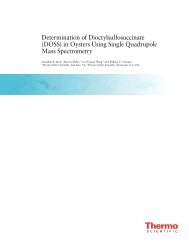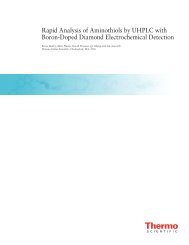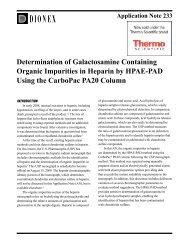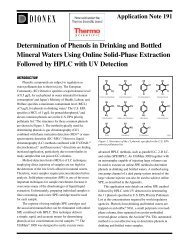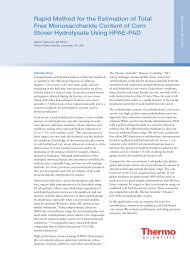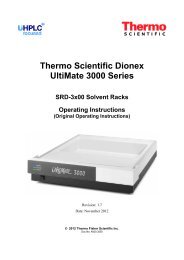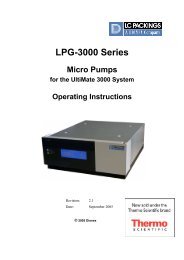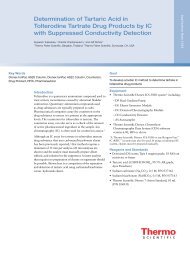Determination of Organotin Compounds in Sediments Using - Dionex
Determination of Organotin Compounds in Sediments Using - Dionex
Determination of Organotin Compounds in Sediments Using - Dionex
You also want an ePaper? Increase the reach of your titles
YUMPU automatically turns print PDFs into web optimized ePapers that Google loves.
<strong>Determ<strong>in</strong>ation</strong> <strong>of</strong> <strong>Organot<strong>in</strong></strong><br />
<strong>Compounds</strong> <strong>in</strong> <strong>Sediments</strong> Us<strong>in</strong>g<br />
Accelerated Solvent Extraction (ASE)<br />
IntroductIon<br />
<strong>Organot<strong>in</strong></strong> compounds (OTs) are a highly versatile<br />
group <strong>of</strong> organometallic chemicals used <strong>in</strong> <strong>in</strong>dustrial and<br />
agricultural applications. Tributylt<strong>in</strong> (TBT) is the most<br />
widely used <strong>of</strong> these compounds and has been under<br />
scrut<strong>in</strong>y due to its significant environmental effects.<br />
<strong>Organot<strong>in</strong></strong> compounds with alkyl or phenyl substituents<br />
exhibit considerable toxicity toward both aquatic<br />
organisms and mammals. 1<br />
Aquatic contam<strong>in</strong>ation from these compounds is<br />
attributed ma<strong>in</strong>ly to leach<strong>in</strong>g <strong>of</strong> anti-foul<strong>in</strong>g mar<strong>in</strong>e<br />
pa<strong>in</strong>ts; however, the grow<strong>in</strong>g use <strong>of</strong> organot<strong>in</strong>s as<br />
agricultural pesticides can potentially contam<strong>in</strong>ate the<br />
aquatic environment by leach<strong>in</strong>g and run<strong>of</strong>f. 2 Annual<br />
worldwide production <strong>of</strong> organot<strong>in</strong> compounds was<br />
estimated to be 33,000 tons <strong>in</strong> 1983. Recent regulatory<br />
legislation <strong>in</strong> the European Community has <strong>in</strong>creased<br />
the need for analytical methods for the determ<strong>in</strong>ation<br />
<strong>of</strong> the tri-substituted organot<strong>in</strong> compounds and their<br />
two degradation products (mono- and dibutylphenylt<strong>in</strong>)<br />
<strong>in</strong> the aquatic environment. Analysis <strong>of</strong> sediments is<br />
<strong>of</strong> particular importance because they are the ultimate<br />
depository <strong>of</strong> these compounds. These accumulated<br />
materials then can be released <strong>in</strong>to the environment,<br />
creat<strong>in</strong>g an environmental hazard long after <strong>in</strong>itial<br />
deposition has ceased.<br />
Trace-level determ<strong>in</strong>ations <strong>of</strong> organot<strong>in</strong> compounds<br />
<strong>in</strong> environmental samples are complicated by the fact that<br />
compounds with 1-3 substituents are non-volatile due<br />
to their polar and ionic character. Traditional methods<br />
for extract<strong>in</strong>g and analyz<strong>in</strong>g these compounds are not<br />
only time consum<strong>in</strong>g but have been shown to have poor<br />
analyte recovery and poor reliability. 3<br />
Application Note 339<br />
Accelerated Solvent Extraction uses a comb<strong>in</strong>ation<br />
<strong>of</strong> <strong>in</strong>creased pressure and temperature to <strong>in</strong>crease the<br />
efficiency <strong>of</strong> the extraction process. ASE ® systems are<br />
currently used <strong>in</strong> the environmental <strong>in</strong>dustry to replace<br />
traditional extraction methods such as sonication and<br />
Soxhlet. Us<strong>in</strong>g an ASE system, extracts can be generated<br />
<strong>in</strong> much less time and us<strong>in</strong>g significantly less solvent than<br />
these traditional methods. ASE systems also have been<br />
shown to provide better or equivalent recoveries compared<br />
to these techniques for compound classes cover<strong>in</strong>g a wide<br />
range <strong>of</strong> polarities and exhibit<strong>in</strong>g both high and low levels<br />
<strong>of</strong> bond<strong>in</strong>g to the matrix.<br />
EquIpmEnt<br />
<strong>Dionex</strong> ASE 200 Accelerated Solvent Extractor*<br />
equipped with 11 mL cells<br />
<strong>Dionex</strong> vials for collection <strong>of</strong> extracts<br />
(40 mL, P/N 49465)<br />
Gas Chromatograph and mass spectrometer<br />
*ASE 150 and 350 can be used for equivalent results<br />
rEagEnts and standards<br />
Methanol (pesticide residue grade, Burdick & Jackson)<br />
Water (HPLC grade, Burdick & Jackson)<br />
Sodium tertraethylborate (NaBEt >98%, Strem<br />
4,<br />
Chemicals)<br />
Sodium acetate (>99%, Merck)<br />
Acetic acid (>99.8%, Merck)<br />
<strong>Organot<strong>in</strong></strong> standards (Fluka)<br />
PACS-1 Reference Sediment (National Research Council<br />
<strong>of</strong> Canada)<br />
RM 424 Reference Material (European Commission,<br />
Community Bureau <strong>of</strong> Reference)<br />
Application Note 339 1
samplE prEparatIon<br />
Samples (2.5 g) <strong>of</strong> freeze-dried sediment were<br />
weighed <strong>in</strong>to 25 mL beakers. The samples were spiked<br />
with 500 µL <strong>of</strong> the OT standard solution, result<strong>in</strong>g <strong>in</strong> a<br />
concentration <strong>of</strong> 100 ng/g. The spiked sediments were<br />
then thoroughly mixed with 9 g <strong>of</strong> sand, transferred to<br />
11 mL extraction cells, and set aside for 2 h prior<br />
to extraction.<br />
ExtractIon condItIons<br />
Extraction Solvent: 1 M Sodium acetate, 1 M acetic<br />
acid <strong>in</strong> methanol (1:1)<br />
Temperature: 100 °C<br />
Pressure: 1500 psi*<br />
Heat-up Time: 5 m<strong>in</strong><br />
Static Time: 5 m<strong>in</strong><br />
Flush Volume: 60%<br />
Purge Time: 100 s<br />
Static Cycles:<br />
Total Extraction<br />
3–5<br />
Time: 25–35 m<strong>in</strong> per sample<br />
Total Solvent Use: 16–20 mL per sample<br />
*Pressure studies show that 1500 psi is the optimum extraction<br />
pressure for all ASE applications.<br />
post-ExtractIon procEdurE<br />
Extracts were transferred to 250 mL volumetric flasks<br />
conta<strong>in</strong><strong>in</strong>g 7.3 g <strong>of</strong> NaCl, diluted with HPLC- grade<br />
water, and then pH-adjusted to 5.0 + 0.1 with 1 M NaOH.<br />
One milliliter <strong>of</strong> a 5% w/v sodium tertraethylborate<br />
aqueous solution (derivatiz<strong>in</strong>g agent) was added to each<br />
flask and the volume was adjusted to 250 mL with water.<br />
F<strong>in</strong>ally, 2 mL <strong>of</strong> hexane was added and the samples were<br />
shaken for 12 h. A 500 µL aliquot <strong>of</strong> the hexane layer was<br />
transferred to a 2 mL GC vial and spiked with 10 µL <strong>of</strong><br />
surrogate standard (tetrabutylt<strong>in</strong>, 50 ng/10 µL). Prior to<br />
analysis, sewage sludge hexane extracts were transferred<br />
to 10 mL centrifuge tubes conta<strong>in</strong><strong>in</strong>g 0.9 g <strong>of</strong> deactivated<br />
silica gel and 2 mL water. The tubes were shaken<br />
vigorously and centrifuged. M<strong>in</strong>or losses were associated<br />
with this clean-up procedure; recoveries averaged 99%.<br />
(Losses were evaluated by putt<strong>in</strong>g standard solutions<br />
through the clean-up procedure.)<br />
Extract analysIs<br />
Sediment extracts were analyzed with a gas<br />
chromatograph coupled to a mass spectrometer. Extracts<br />
(1 µL) were <strong>in</strong>jected on-column except for sewage<br />
sludge extracts, which were <strong>in</strong>jected <strong>in</strong> the splitless mode<br />
(<strong>in</strong>jector temperature 200 °C). The GC was equipped with<br />
a 2 m × 0.53 mm deactivated fused silica precolumn and a<br />
30 m × 0.32 mm capillary column (film thickness<br />
0.25 µm). The helium flow velocity was regulated at<br />
50 cm/s. Temperature programm<strong>in</strong>g was performed as<br />
follows: 1 m<strong>in</strong> at 60 °C, to 250 °C at 10 °C/m<strong>in</strong>, and<br />
4 m<strong>in</strong> at 250 °C. The GC-MSD <strong>in</strong>terface temperature was<br />
set to 300 °C. Detection was performed <strong>in</strong> the electron<br />
impact ionization mode and s<strong>in</strong>gle-ion monitor<strong>in</strong>g (SIM).<br />
Correct identification and quantification <strong>of</strong> a given analyte<br />
was assured by us<strong>in</strong>g two compound-specific ions and a<br />
mass ratio similar to the one determ<strong>in</strong>ed with calibration<br />
(variation
Table 1. Absolute and Relative Recoveries, RSDs, and<br />
MDLs Determ<strong>in</strong>ed from Lake <strong>Sediments</strong><br />
1000 ng/g spike (n=3) 10 ng/g spike (n=5)<br />
Compound a Absolute<br />
Recovery b<br />
Relative<br />
Recovery c<br />
Relative<br />
Recovery c<br />
MDL d<br />
(ng/g)<br />
% RSD % RSD % RSD<br />
MBT 97 4 100 1 105 3 0.9<br />
DBT 100 2 102 3 101 2 0.5<br />
TBT 98 6 102 2 100 4 1.1<br />
MPT 80 7 87 3 104 7 2.0<br />
DPT 95 6 97 2 98 1 0.4<br />
TPT 94 (5) 100 (2) 101 (2) 0.5<br />
TCyT 73 (4) 72 (2) 51 (4) 1.0<br />
a Compound abbreviations: monobutylt<strong>in</strong> (MBT), tributylt<strong>in</strong> (TBT), dibutylt<strong>in</strong> (DBT),<br />
monophenylt<strong>in</strong> (MPT), diphenylt<strong>in</strong> (DPT), triphenylt<strong>in</strong> (TPT), tricyclohexylt<strong>in</strong> (TCyT)<br />
b Absolute recoveries determ<strong>in</strong>ed by addition <strong>of</strong> <strong>in</strong>ternal standard to sediment extracts<br />
c Relative extraction recoveries determ<strong>in</strong>ed by addition <strong>of</strong> <strong>in</strong>ternal standard to sediments prior<br />
to extraction<br />
d MDL = three times the standard deviation <strong>of</strong> the low spike concentration<br />
<strong>in</strong> standard reference materials PACS-1 and RM 424<br />
sediments. Data shown <strong>in</strong> Table 2 <strong>in</strong>dicate that DBT and<br />
TBT concentrations were <strong>in</strong> excellent agreement with the<br />
certified values for the PACS-1 sediment, whereas the<br />
concentration <strong>of</strong> MBT exceeded the certified value by a<br />
factor <strong>of</strong> 2.4. This is <strong>in</strong> agreement with other published<br />
evaluations <strong>of</strong> this material. 4 Because no degradation <strong>of</strong><br />
DBT or TBT was observed, it is assumed that quantitative<br />
recovery <strong>of</strong> MBT was not achieved with the analytical<br />
methods used <strong>in</strong> the validation process <strong>of</strong> the PACS-1<br />
material. Concentrations <strong>of</strong> MPT, DPT, and TPT were<br />
also detected <strong>in</strong> the PACS-1 sediment, although the<br />
material is not certified for these compounds. The RM<br />
424 sediment is a difficult matrix due to its high organic<br />
content and low OT concentrations. Recoveries shown<br />
<strong>in</strong> Table 3 are <strong>in</strong> excellent agreement with the certified<br />
values for the three OT compounds.<br />
Table 2. Recoveries and Certified Values <strong>of</strong> <strong>Organot<strong>in</strong></strong><br />
<strong>Compounds</strong> from PACS-1 Reference Sediment<br />
Compound Recovery (ng/g, n=5) Certified Value<br />
MBT 672 + 11 280 + 70<br />
DBT 990 + 44 1160 + 180<br />
TBT 1133 + 15 1270 + 220<br />
MPT 62 + 5 na<br />
DPT 8 + 2 na<br />
TPT 70 + 8 na<br />
Table 3. Recoveries and Certified Values <strong>of</strong> <strong>Organot<strong>in</strong></strong><br />
<strong>Compounds</strong> from RM 424 Reference Sediment<br />
Compound Recovery (ng/g, n=9) Certified Value<br />
MBT 165 + 5 174 + 36<br />
DBT 22 + 1 27 + 10<br />
TBT 6.5 + 0.2 8 + 2<br />
conclusIon<br />
The data presented here <strong>in</strong>dicate that the ASE<br />
system provides excellent recovery and precision for<br />
the extraction <strong>of</strong> organot<strong>in</strong> compounds from spiked<br />
and natural sediment samples. Us<strong>in</strong>g an ASE system,<br />
extraction times can be reduced and the sample<br />
preparation process automated to make more efficient use<br />
<strong>of</strong> laboratory resources.<br />
Application Note 339 3
acknowlEdgmEnts<br />
The work <strong>of</strong> Cedric Arnold, Michael Berg, Stephan<br />
Muller, Urs Domman, and Rene Schwarzenbach <strong>of</strong> the<br />
Swiss Federal Institute for Environmental Science and<br />
Technology (EAWAG), and the Swiss Federal Institute <strong>of</strong><br />
Technology, orig<strong>in</strong>ally published <strong>in</strong> Anal. Chem. 1998,<br />
70, 3094–3101, is gratefully acknowledged.<br />
rEfErEncEs<br />
1. Muller, M. Anal. Chem. 1987, 59, 617–623.<br />
2. Cal, Y., Alzaga, R., and Bayona, J. Anal. Chem. 1994,<br />
66, 1161–1167.<br />
3. Donard, O., Lalere, B., Mart<strong>in</strong>, F., and Lob<strong>in</strong>ski, R.<br />
Anal. Chem. 1995, 67, 4250–4254.<br />
4. Szpunar, J., Schmitt, V., Lob<strong>in</strong>ski, R., and Monod, J.<br />
J. Anal. Atom. Spectrom. 1996, 11, 193–199.<br />
Speed • Simplicity • Solutions<br />
<strong>Dionex</strong> Corporation<br />
1228 Titan Way<br />
P.O. Box 3603<br />
Sunnyvale, CA<br />
94088-3603<br />
(408) 737-0700<br />
North America<br />
U.S./Canada (847) 295-7500<br />
South America<br />
Brazil (55) 11 3731 5140<br />
Europe<br />
Austria (43) 1 616 51 25 Benelux (31) 20 683 9768 (32) 3 353 4294<br />
Denmark (45) 36 36 90 90 France (33) 1 39 30 01 10 Germany (49) 6126 991 0<br />
Ireland (353) 1 644 0064 Italy (39) 02 51 62 1267 Sweden (46) 8 473 3380<br />
Switzerland (41) 62 205 9966 United K<strong>in</strong>gdom (44) 1276 691722<br />
lIst <strong>of</strong> supplIErs<br />
Merck, Frankfurter Str. 250, D-64293 Darmstadt, Germany,<br />
Tel: +49 61 51 72 0<br />
Fluka Chemika-BioChemika, Industriestrasse 25, Buchs<br />
CH-9471, Switzerland, Tel: +081 755 25 11<br />
Burdick & Jackson, 1953 South Harvey Street,<br />
Muskegon, MI 49442, USA, Tel: 1-800-368-0050<br />
Strem Chemicals Inc., 7 Mulliken Way, Newburyport,<br />
MA 01950, USA, Tel: 1-508-462-3191<br />
ASE is a registered trademark <strong>of</strong> <strong>Dionex</strong> Corporation.<br />
Asia Pacific<br />
Australia (61) 2 9420 5233 Ch<strong>in</strong>a (852) 2428 3282 India (91) 22 2764 2735<br />
Japan (81) 6 6885 1213 Korea (82) 2 2653 2580 S<strong>in</strong>gapore (65) 6289 1190<br />
Taiwan (886) 2 8751 6655<br />
LPN 1184-2 PDF 4/11<br />
©2011 <strong>Dionex</strong> Corporation<br />
www.dionex.com




